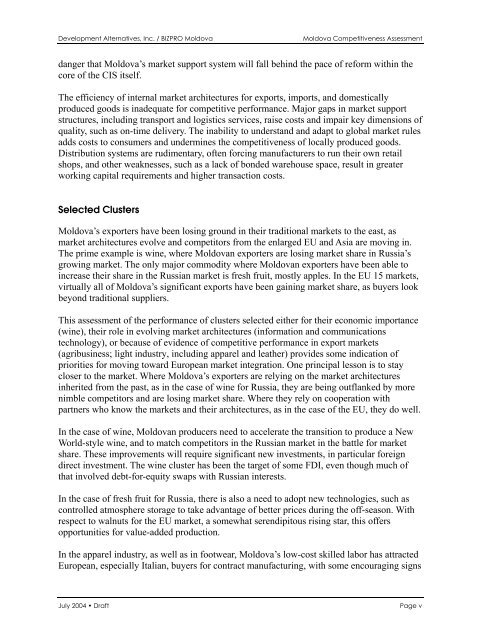Assessing Competitiveness In Moldova's Economy - Economic Growth
Assessing Competitiveness In Moldova's Economy - Economic Growth
Assessing Competitiveness In Moldova's Economy - Economic Growth
Create successful ePaper yourself
Turn your PDF publications into a flip-book with our unique Google optimized e-Paper software.
Development Alternatives, <strong>In</strong>c. / BIZPRO Moldova Moldova <strong>Competitiveness</strong> Assessment<br />
danger that Moldova’s market support system will fall behind the pace of reform within the<br />
core of the CIS itself.<br />
The efficiency of internal market architectures for exports, imports, and domestically<br />
produced goods is inadequate for competitive performance. Major gaps in market support<br />
structures, including transport and logistics services, raise costs and impair key dimensions of<br />
quality, such as on-time delivery. The inability to understand and adapt to global market rules<br />
adds costs to consumers and undermines the competitiveness of locally produced goods.<br />
Distribution systems are rudimentary, often forcing manufacturers to run their own retail<br />
shops, and other weaknesses, such as a lack of bonded warehouse space, result in greater<br />
working capital requirements and higher transaction costs.<br />
Selected Clusters<br />
Moldova’s exporters have been losing ground in their traditional markets to the east, as<br />
market architectures evolve and competitors from the enlarged EU and Asia are moving in.<br />
The prime example is wine, where Moldovan exporters are losing market share in Russia’s<br />
growing market. The only major commodity where Moldovan exporters have been able to<br />
increase their share in the Russian market is fresh fruit, mostly apples. <strong>In</strong> the EU 15 markets,<br />
virtually all of Moldova’s significant exports have been gaining market share, as buyers look<br />
beyond traditional suppliers.<br />
This assessment of the performance of clusters selected either for their economic importance<br />
(wine), their role in evolving market architectures (information and communications<br />
technology), or because of evidence of competitive performance in export markets<br />
(agribusiness; light industry, including apparel and leather) provides some indication of<br />
priorities for moving toward European market integration. One principal lesson is to stay<br />
closer to the market. Where Moldova’s exporters are relying on the market architectures<br />
inherited from the past, as in the case of wine for Russia, they are being outflanked by more<br />
nimble competitors and are losing market share. Where they rely on cooperation with<br />
partners who know the markets and their architectures, as in the case of the EU, they do well.<br />
<strong>In</strong> the case of wine, Moldovan producers need to accelerate the transition to produce a New<br />
World-style wine, and to match competitors in the Russian market in the battle for market<br />
share. These improvements will require significant new investments, in particular foreign<br />
direct investment. The wine cluster has been the target of some FDI, even though much of<br />
that involved debt-for-equity swaps with Russian interests.<br />
<strong>In</strong> the case of fresh fruit for Russia, there is also a need to adopt new technologies, such as<br />
controlled atmosphere storage to take advantage of better prices during the off-season. With<br />
respect to walnuts for the EU market, a somewhat serendipitous rising star, this offers<br />
opportunities for value-added production.<br />
<strong>In</strong> the apparel industry, as well as in footwear, Moldova’s low-cost skilled labor has attracted<br />
European, especially Italian, buyers for contract manufacturing, with some encouraging signs<br />
July 2004 • Draft Page v
















